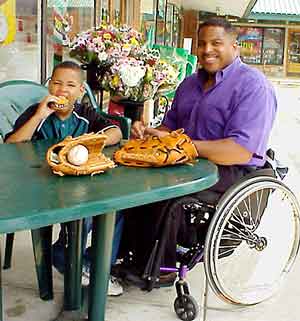
Bullying, a form of violence among children, is common on school playgrounds, in neighborhoods, and in homes throughout the United States and around the world. Often occurring out of the presence of adults or in front of adults who fail to intercede, bullying has long been considered an inevitable and, in some ways, uncontrollable part of growing up.
School bullying has come under intense public and media scrutiny recently amid reports that it may have been a contributing factor in shootings at Columbine High School in Littleton, CO, in 1999 and Santana High School in Santee, CA, in early 2001 and in other acts of juvenile violence including suicide. Bullying can affect the social environment of a school, creating a climate of fear among students, inhibiting their ability to learn, and leading to other antisocial behavior. Nevertheless, through research and evaluation, successful programs to recognize, prevent, and effectively intervene in bullying behavior have been developed and replicated in schools across the country. These schools send the message that bullying behavior is not tolerated and, as a result, have improved safety and created a more inclusive learning environment.
A recently published report by the National Institute of Child Health and Human Development (NICHD) on the U.S. contribution to the World Health Organization's Health Behavior in School-Aged Children survey found that 17 percent of the respondents had been bullied "sometimes" or "weekly," 19 percent had bullied others sometimes or weekly, and 6 percent had both bullied others and been bullied. The researchers estimated that 1.6 million children in grades 6 through 10 in the United States are bullied at least once a week and 1.7 million children bully others as frequently. The survey, the first nationwide research on the problem in this country, questioned 15,686 public and private school students, grades 6 through 10, on their experiences with bullying. In a study of 6,500 middle school students in rural South Carolina, 23 percent said they had been bullied regularly during the previous 3 months and 20 percent admitted bullying another child regularly during that time (Olweus and Limber, 1999).
What Is Bullying?
Bullying among children encompasses a variety of negative acts carried out repeatedly over time. It involves a real or perceived imbalance of power, with the more powerful child or group attacking those who are less powerful. Bullying can take three forms: physical (hitting, kicking, spitting, pushing, taking personal belongings); verbal (taunting, malicious teasing, name calling, making threats); and psychological (spreading rumors, manipulating social relationships, or engaging in social exclusion, extortion, or intimidation).
The NICHD survey found that males tend to bully and be bullied more frequently than females. For males, experiencing physical and verbal bullying is most common; for females, verbal bullying (both taunting and insults of a sexual nature) and spreading rumors are most common. Bullying generally begins in the elementary grades, peaks in the sixth through eighth grades, and persists into high school.
The Effects of Bullying

The NICHD study found that bullying has long-term and short-term psychological effects on both those who bully and those who are bullied. Victims experienced loneliness and reported having trouble making social and emotional adjustments, difficulty making friends, and poor relationships with classmates. Victims of bullying often suffer humiliation, insecurity, and a loss of self-esteem, and they may develop a fear of going to school. The impact of frequent bullying often accompanies these victims into adulthood; they are at greater risk of suffering from depression and other mental health problems, including schizophrenia. In rare cases, they may commit suicide.
Bullying behavior has been linked to other forms of antisocial behavior, such as vandalism, shoplifting, skipping and dropping out of school, fighting, and the use of drugs and alcohol. Pioneering research by Professor Dan Olweus in Norway and Sweden suggests that bullying can lead to criminal behavior later in life: 60 percent of males who were bullies in grades 6 through 9 were convicted of at least one crime as adults, compared with 23 percent of males who did not bully; 35 to 40 percent of these former bullies had three or more convictions by age 24, compared with 10 percent of those who did not bully.
The NICHD study found that those who bully and are bullied appear to be at greatest risk of experiencing the following: loneliness, trouble making friends, lack of success in school, and involvement in problem behaviors such as smoking and drinking.
Addressing the Problem
A perpetrator's bullying behavior does not exist in isolation. Rather, it may indicate the beginning of a generally antisocial and rule-breaking behavior pattern that can extend into adulthood. Programs to address the problem, therefore, must reduce opportunities and rewards for bullying behavior. The Olweus Bullying Prevention Program, developed, refined, and systematically evaluated in Bergen, Norway, in the mid-1980s, is the best-known initiative designed to reduce bullying among elementary, middle, and junior high school children (Olweus and Limber, 1999). The strategy behind the program is to involve school staff, students, and parents in efforts to raise awareness about bullying, improve peer relations, intervene to stop intimidation, develop clear rules against bullying behavior, and support and protect victims. The program intervenes on three levels:
- School: Faculty and staff survey students anonymously to determine the nature and prevalence of the school's bullying problem, increase supervision of students during breaks, and conduct schoolwide assemblies to discuss the issue. Teachers receive inservice training on how to implement the program.
- Classroom: Teachers and/or other school personnel introduce and enforce classroom rules against bullying, hold regular classroom meetings with students to discuss bullying, and meet with parents to encourage their participation.
- Individual: Staff intervene with bullies, victims, and their parents to ensure that the bullying stops.
The Bergen research showed that the program was highly effective among students in elementary, middle, and junior high schools: Bullying dropped by 50 percent or more during the program's 2 years. Behavioral changes were more pronounced the longer the program was in effect. The school climate improved, and the rate of antisocial behavior, such as theft, vandalism, and truancy, declined during the 2-year period.
Other Related Articles:
- Help Your Kids Stay Safe Online
- Choosing a School: First Steps
- Choosing a School: Explore Your Options
- Choosing a School: How to Evaluate
- Dept. of Education Guide to Choosing a School
- Parents Page at Dept of Education
 Print
Print Email
Email







